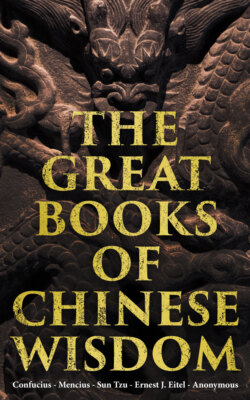Читать книгу The Great Books of Chinese Wisdom - Mencius - Страница 65
ОглавлениеHexagram XLIX.49 Ko
(What takes place as indicated by) Ko is believed in only after it has been accomplished. There will be great progress and success. Advantage will come from being firm and correct. (In that case) occasion for repentance will disappear.
1. The first line, undivided, shows its subject (as if he were) bound with the skin of a yellow ox.
2. The second line, divided, shows its subject making his changes after some time has passed. Action taken will be fortunate. There will be no error.
3. The third line, undivided, shows that action taken by its subject will be evil. Though he be firm and correct, his position is perilous. If the change (he contemplates) have been three times fully discussed, he will be believed in.
4. The fourth line, undivided, shows occasion for repentance disappearing (from its subject). Let him be believed in; and though he change (existing) ordinances, there will be good fortune.
5. The fifth line, undivided, shows the great man (producing his changes) as the tiger (does when he) changes (his stripes). Before he divines (and proceeds to action), faith has been reposed in him.
6. The sixth line, divided, shows the superior man producing his changes as the leopard (does when he) changes (his spots), while small men change their faces (and show their obedience). To go forward (now) would lead to evil, but there will be good fortune in abiding firm and correct.
Footnotes
49. The character called Ko or Keh is used here in the sense of changing. Originally used for the skin of an animal or bird, alive or dead, it received the significance of changing at a very early time. Its earliest appearance, indeed, in the first Book of the Shû, is in that sense. How the transition was made from the idea of a skin or hide to that of change is a subject that need not be entered on here. The author has before him the subject of changes occurring--called for--in the state of the country; it may be on the greatest scale. The necessity of them is recognised, and hints are p. 169 given as to the spirit and manner in which they should be brought about.
For the way in which the notion of change is brought out of the trigrams of the figure, see Appendixes I and II. It is assumed in the Thwan that change is viewed by people generally with suspicion and dislike, and should not be made hastily. When made as a necessity, and its good effects appear, the issues will be great and good. A proved necessity for them beforehand; and a firm correctness in the conduct of them:--these are the conditions by which changes should be regulated.
Line 1, at the bottom of the figure, may be taken as denoting change made at too early a period. It has no proper correlate or helper, moreover, above. Hence its subject is represented as tied up, unable to take any action.
Line 2, though weak, is in its correct place. It is in the centre also of the trigram Lî, signifying brightness and intelligence, and has a proper correlate in the strong 5. Let its subject take action in the way of change.
The symbolism of paragraph 3 is twofold. The line is strong, and in the correct position, but it has passed the centre of Sun and is on its outward verge. These conditions may dispose its subject to reckless and violent changing which would be bad. But if he act cautiously and with due deliberation, he may take action, and he will be believed in.
Line 4 is strong, but in the place of a weak line. This might vitiate any action of its subject in the way of change, and give occasion for repentance. But other conditions are intimated that p. 170 will have a contrary effect; and if he have further secured general confidence, he may proceed to the greatest changes, even to change the dynasty,--'with good fortune.' The conditions favourable to his action are said to be such as these:--The line has passed from the lower trigram into the upper; water and fire come in it into contact; the fourth place is that of the minister immediately below the ruler's seat. All these considerations demand action from the subject of 4 in harmony with the idea of the hexagram.
Line 5 has every quality proper to 'the lord of the hexagram,' and his action will be in every way beneficial. He is symbolled by the tiger; and the changes which he makes by the bright stripes of the tiger when he has changed his coat.
Line 6 is weak, but its subject is penetrated with the spirit of the hexagram. If its subject be a superior man, only inferior to 'the great man,' immediately below, the changes he makes will be inferior only to his. If he be a small man, he will be compliant and submissive. The lesson for him, however, is to abide firm and correct without taking any action of his own.
